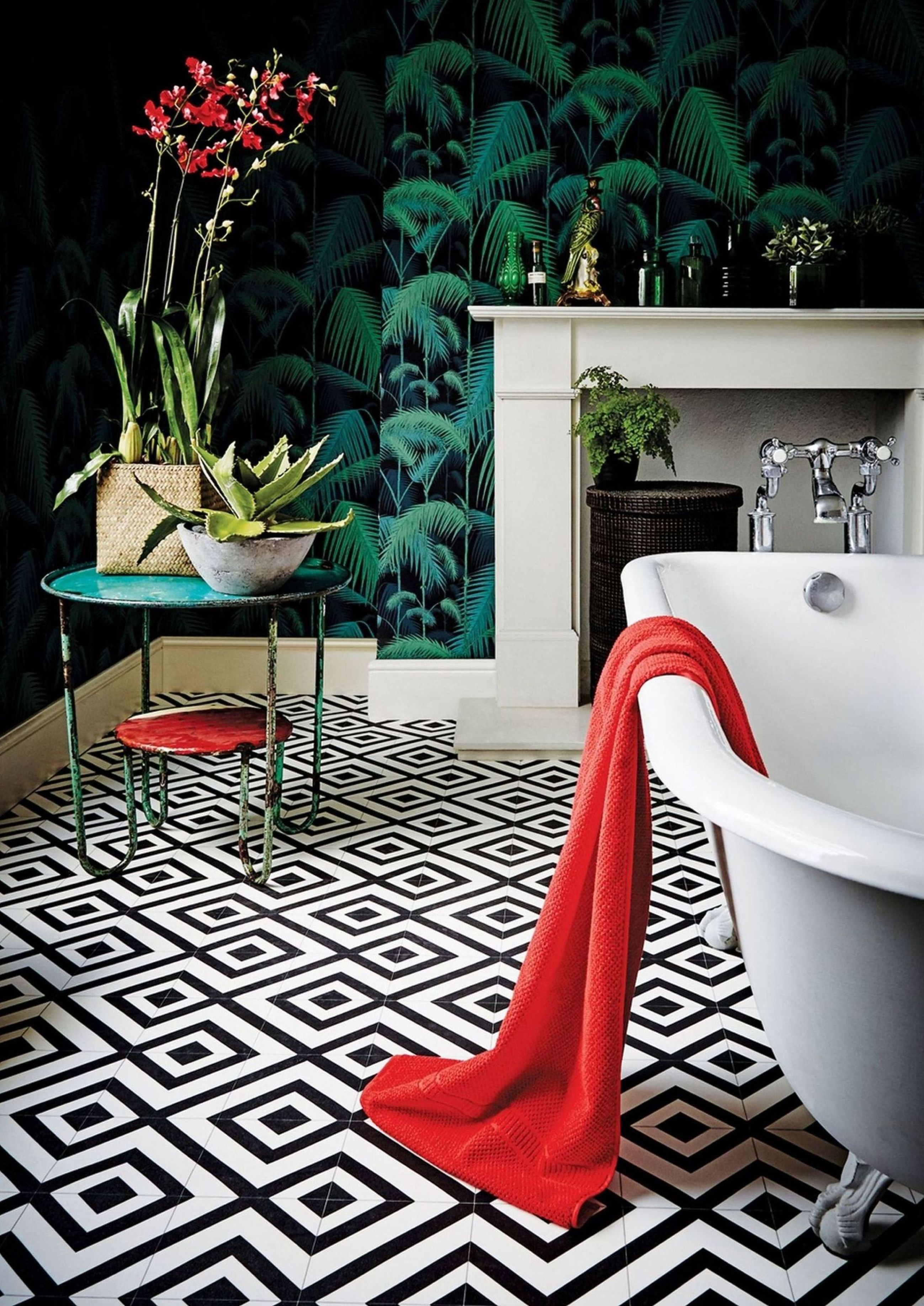

Bathroom flooring ideas need to be practical as well as stylish. Able to cope with the humidity of the room, along with splashes and spills – especially important if kids are using the space...
There are a host of different types of bathroom flooring on offer from porcelain and ceramic to natural stone tile, luxury vinyl flooring, laminate, wood and more. You need to find an option that has the look you love to suit your favorite bathroom ideas and that also ticks all the boxes when it comes to functionality. Easy maintenance and slip-resistant options are all high on the list of criteria needed for bathroom flooring so that you can keep the room hygienic and safe as well as looking its best.
Bathroom flooring ideas: the best types, and how to care for them
When you’re upgrading a bathroom, you can pick from most types of flooring to create a safe, hygienic and great-looking room, it depends on the style you want, the level of upkeep and of course, your budget.
1. Opt for easy-care porcelain or ceramic tile
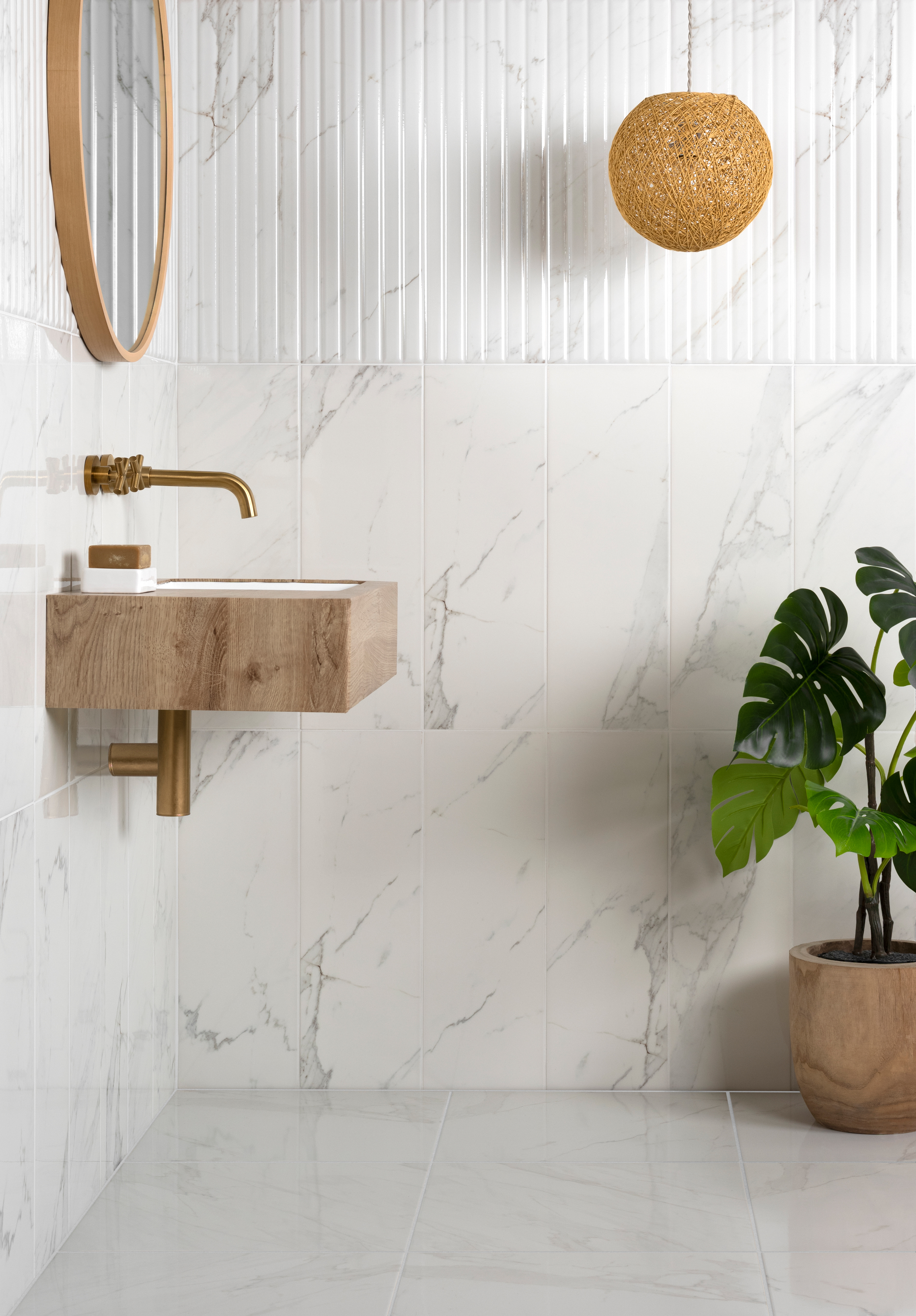
Among the different types of floor tiles on offer, either porcelain or ceramic are great bathroom flooring ideas. There’s an enormous choice of colors, styles and sizes, and both are easy to care for and clean, as well as durable.
Of the two types of bathroom flooring, porcelain tile is denser. It absorbs less water and is the more hard wearing. However, ceramic tile is also suitable for a bathroom floor as this isn’t a heavy traffic area. It is also likely to cost less.
Choose: There’s a huge range of both porcelain and ceramic tile to select from, and you can go plain or patterned. And, if you like the idea of a wood or natural stone floor but don’t want the care requirements, think porcelain as it can be a great lookalike.
Avoid: Any ceramic tile not identified as suitable for a bathroom floor; some are for walls only.
Design know-how: Choose large tiles to complement a big, contemporary or industrial-style room; smaller tiles are perfect for a vintage look. Bold colors or monochromes in graphic designs are a popular look, as are wood-effect tiles in a parquet layout.
Fitting porcelain and ceramic tile flooring: Tiling a floor is a job that DIYers can tackle, but you will find that ceramic tile is easier to cut. Simply start by finding the centre of the room and lay out the first four tiles with spacers around that point. Then, lay out a few more tiles in each direction to ensure you don’t end up with any awkward, thin slivers of tile at the edges of the room. This done, you can apply adhesive in small sections to keep it from drying out.
Cleaning porcelain and ceramic tile flooring: Vacuum and mop using warm water and mild detergent to clean bathroom tiles effectively.
Expert advice: ‘My biggest tip for selecting bathroom floor tile is to focus on scale,’ says interior designer Julie Arnold of J Raine Design. ‘Scale is such a big factor when choosing a tile not only for aesthetic purposes but also for safety.
‘Although I love the look of a super sleek and clean large format tile in a shower, it does have safety hazards. Choosing a smaller tile with more grout lines provides more friction underneath the homeowner’s feet which creates less of a slip hazard on a wet surface.’
2. Go for natural stone for bathroom flooring
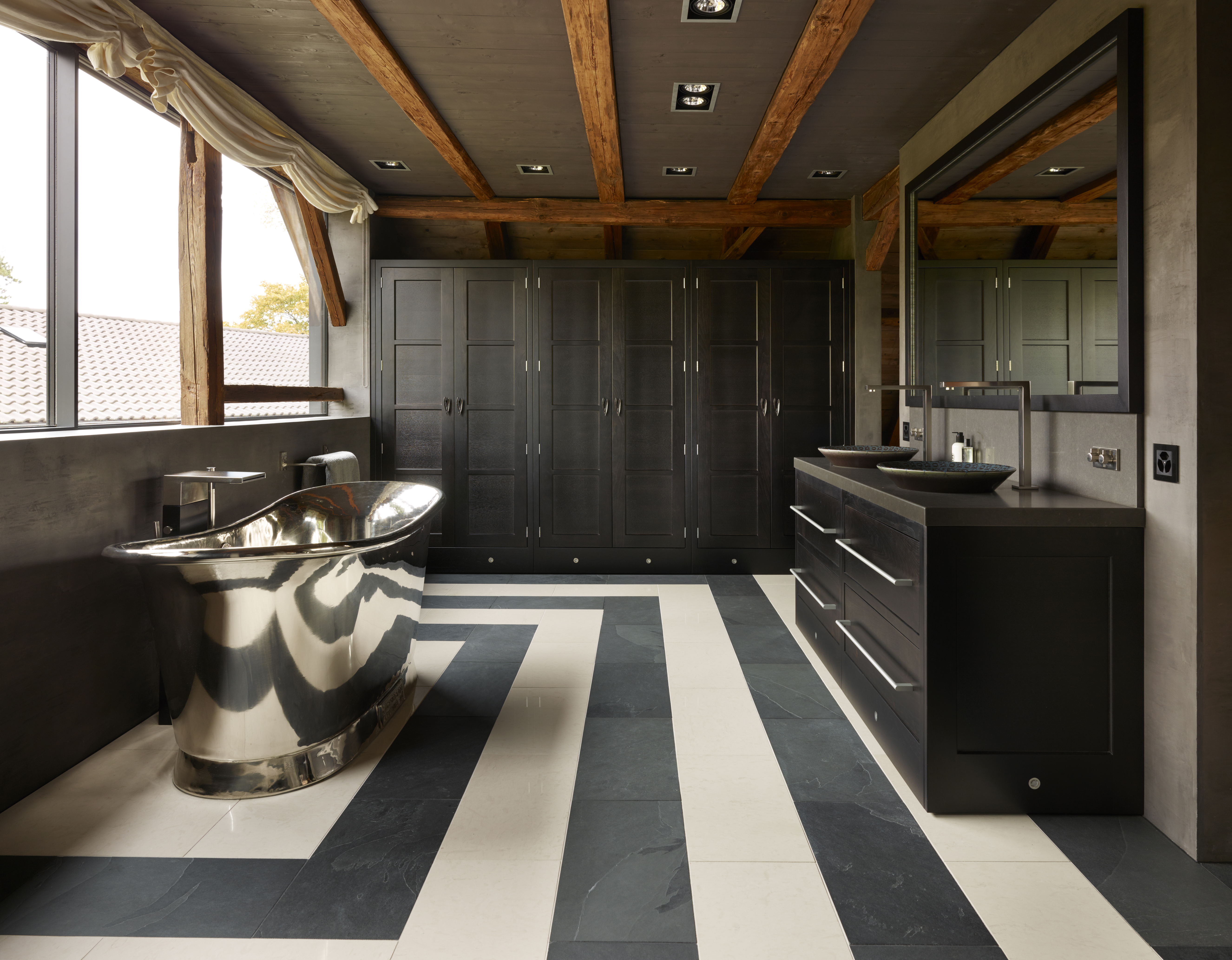
When remodeling a bathroom there are lots of ways to incorporate stone flooring into your design. For plenty of people it is the best bathroom flooring because it’s a natural material and each floor is unique.
Choose: Marble is a classic choice for a bathroom floor but you might also want to consider options such as slate, limestone, travertine and granite. Bear in mind that stone is naturally porous, so you should take advice from an expert supplier on sealing your choice.
Avoid: Natural stone generally if you don’t have time to dedicate to its maintenance.
Design know-how: Natural stone can have bold color and/or striking veining, or be a more understated feature; it’s truly versatile and can be part of either traditional or modern schemes.
Fitting natural stone flooring: It’s generally recommended that you call on a contractor experienced in fitting natural stone to lay this tile in your bathroom given its cost and for best results.
Cleaning natural stone flooring: You can sweep, vacuum and mop a natural stone bathroom floor, but it’s crucial to use a product appropriate for your tile not a general household cleaner. Bear in mind that the floor will also need to resealed from time to time.
3. Choose wood for an effortlessly chic look
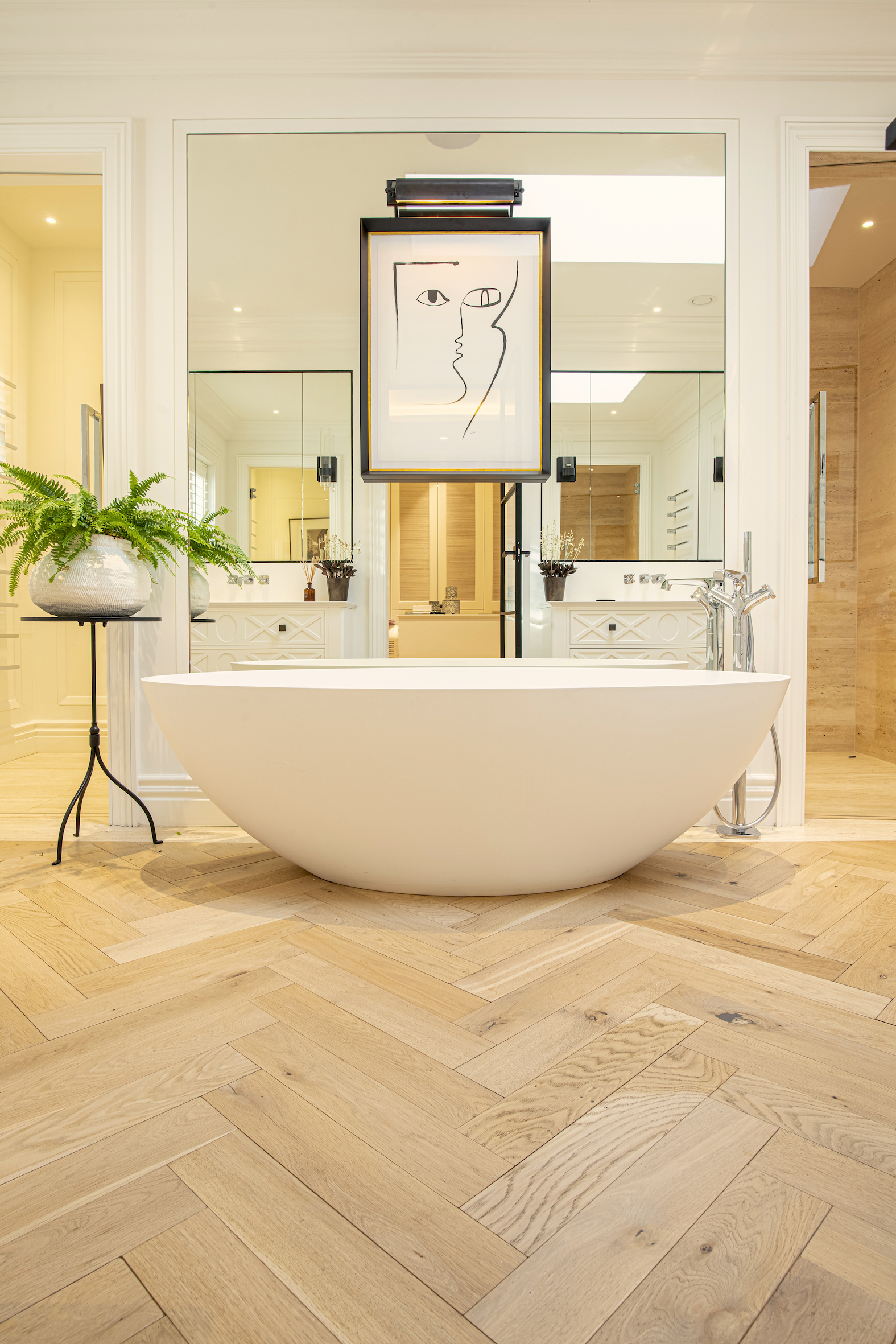
Wood flooring is the best bathroom flooring for some homeowners because it will provide a warmth that tile will not.
Choose: Most suppliers recommend the use of engineered wood when the floor is to be laid in a bathroom. This is still real wood, but it has a layered structure to resist movement due to the room’s conditions. Always check with your supplier to make sure your choice is recommended for a bathroom to avoid problems with the warranty.
Avoid: Solid wood is not generally recommended and again you should be careful of voiding a warranty.
Design know-how: Wood flooring will look fantastic in a period bathroom; pick a parquet floor for the most elegant look.
Fitting wood flooring: Most of the ranges now come as a floating floor with a click-lock system, so competent DIYers will be able to install this type of flooring themselves. However, if your bathroom is an awkward shape or you’re laying it around existing fittings, consider hiring a professional.
Caring for wooden bathroom flooring: Once laid, engineered wood should be treated as when cleaning wood flooring. Swept regularly or vacuumed using a brush setting. Mop up any spills immediately. Clean engineered wood flooring with a damp good quality mop but don’t saturate the surface or allow it to become too wet.
4. Pick laminate to create style for less
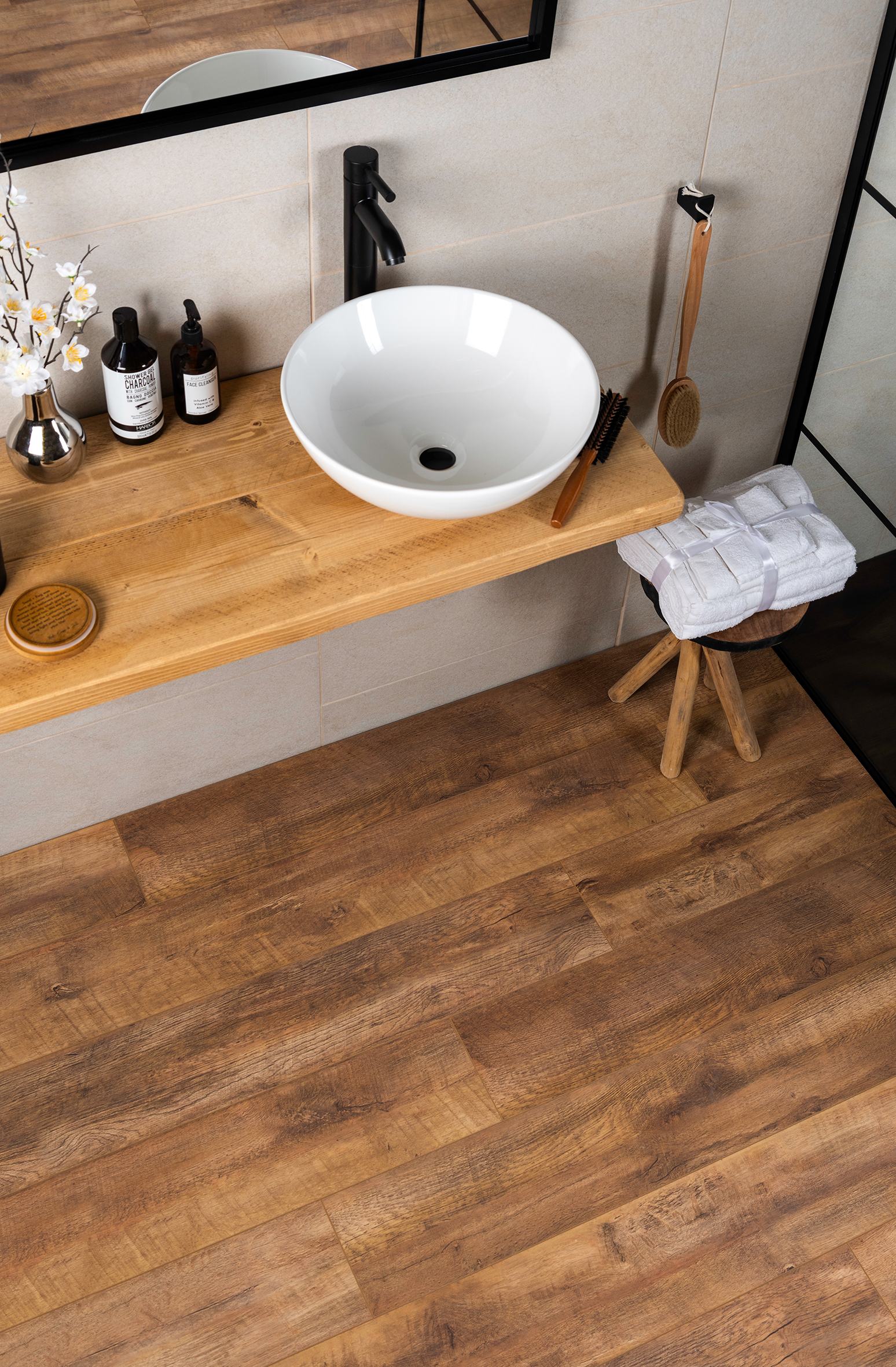
Quality laminate flooring is one of the types of bathroom flooring that’s cost-effective, durable, and versatile. It can create the look of wood without the cost.
Choose: Go for a laminate that is specified for bathrooms so it’s suitable for the conditions.
Avoid: Any laminate not specified for bathrooms.
Design know-how: For a wood effect, pick the most realistic finish you can find, complete with beveled edges and authentic-looking grain. Similarly, beveled edges and realistic detailing will be evident in the best tile-effect laminates, too.
Fitting laminate flooring: You can lay laminate as a DIY job, but if your bathroom is an awkward shape or you're laying it around existing fittings, consider hiring a professional. Laminate must be correctly laid and sealed to prevent rot and mold. Invest in the recommended underlay to prevent future damage and uneven wear.
Cleaning laminate flooring: Sweep with a soft brush or vacuum. Make sure you mop up spills immediately, though.
5. Select comfortable vinyl or rubber bathroom flooring
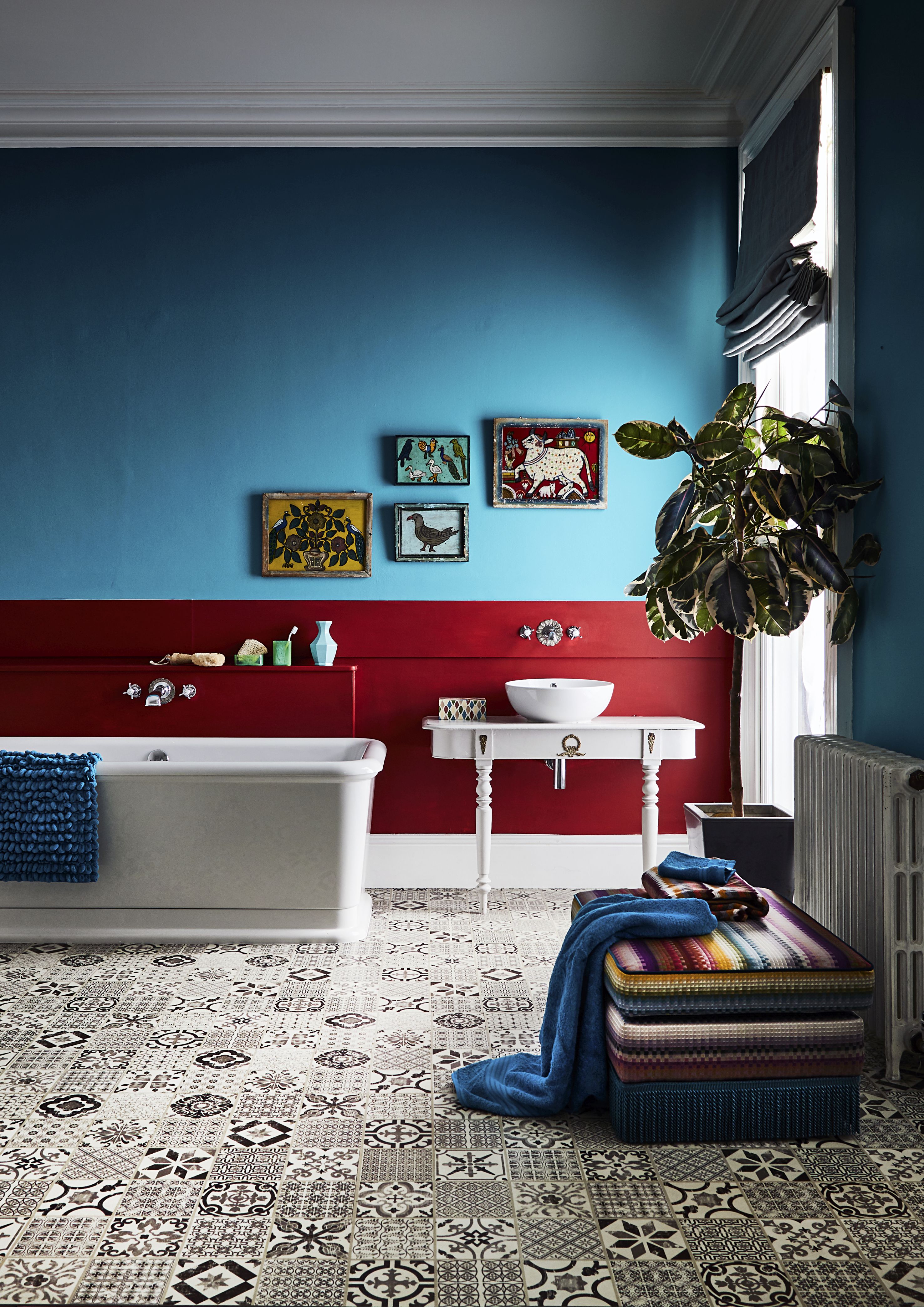
Looking for alternative bathroom flooring ideas? If you like the idea of a floor that’s warm underfoot, comfortable to stand on, and forgiving of dropped objects in a way that tile and even wood aren’t, consider the best vinyl flooring or even rubber.
Choose: Luxury vinyl plank or luxury vinyl tile, which are both great options for bathrooms. They can create the look of wood and natural stone, but are far easier to care for. Patterned designs are also options. Rubber flooring is a great alternative.
Avoid: Very cheap options. The best vinyl has a good wear layer and a realistic look.
Design know-how: With the wide range of colors, patterns, and finishes, vinyl and rubber are great for creating a contemporary look. You may want to steer clear of these materials in a traditional bathroom.
Fitting vinyl and rubber flooring: Some products require adhesives for installation, while others come with a peel-off sticky backing or click together like laminate boards. You can totally install vinyl plank yourself, tiles or planks. Note however that if you are laying a single sheet in a large room, then one wrong cut can be an expensive mistake, and is best left to a professional.
Maintaining vinyl and rubber bathroom flooring: Use a mop, warm water, and mild detergent. Avoid anything abrasive.
Expert advice: ‘LVP (luxury vinyl plank) is an excellent option for a DIYer,’ says Jeff Shipwash, owner of Shipwash Properties. ‘If you purchase the click-lock style, it is quick and easy to install. LVP can be installed in a bathroom in less than a day, even by someone who has never installed it. It’s easy to cut around objects such as toilets and vanities as well.
‘Make sure you purchase an LVP that is waterproof and already has the backing on it. Not all LVP is waterproof, and not all come with a backing. Buying a brand that provides both will alleviate a lot of stress and make your project much more simple.’
6. Choose paint for a budget bathroom floor
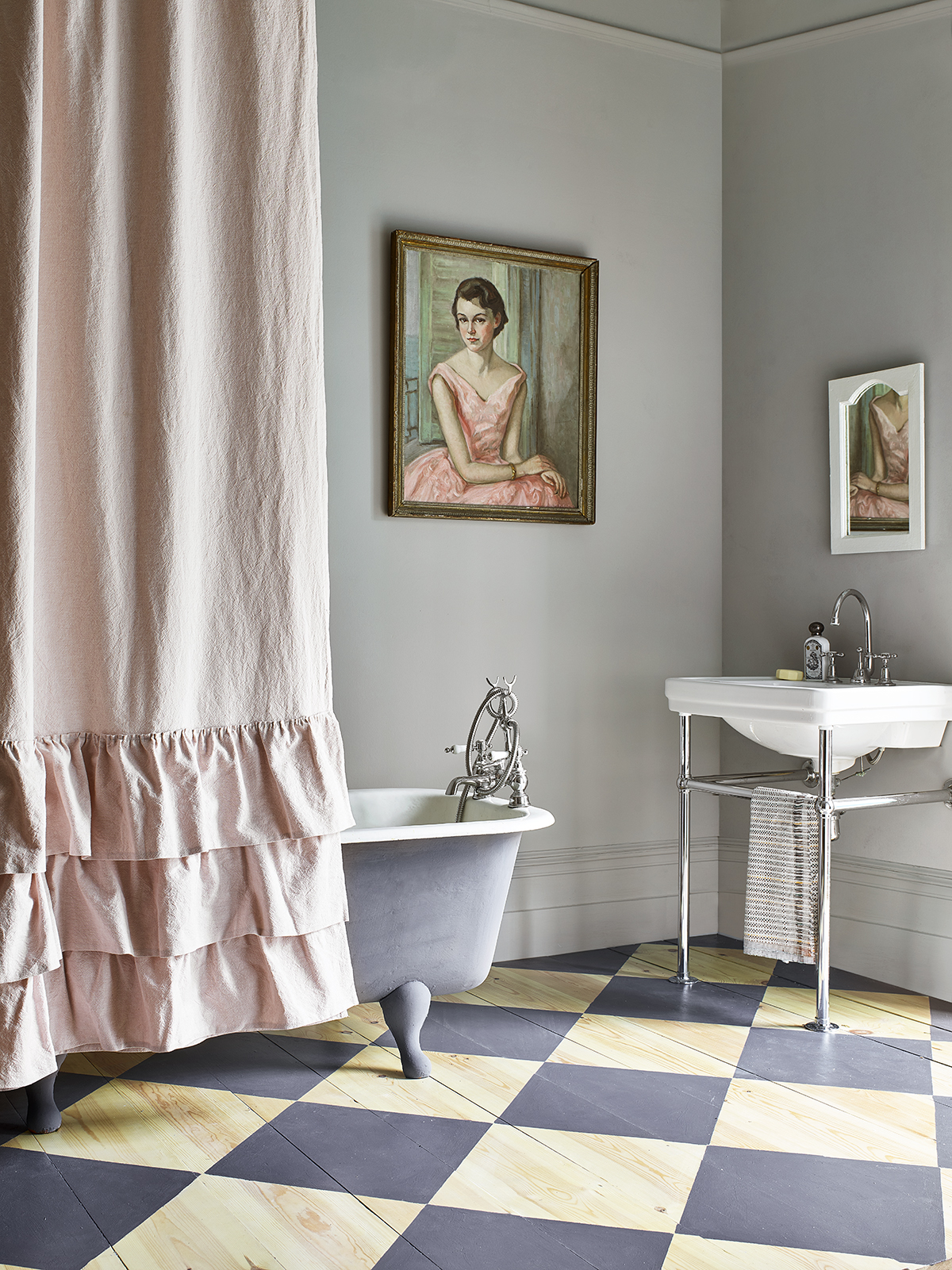
You can still upgrade your flooring when choosing budget bathroom ideas. Painting a bathroom floor – usually on to scrubbed pine floorboards – is a good option if you don’t have much to spend. Ensure you choose a specialist floor paint and prepare the floorboards thoroughly before applying the paint.
What flooring is best for bathrooms?
The best bathroom flooring for you will depend on who is going to use the bathroom, the look you want to create, and your budget.
Bear in mind that a bathroom that’s used by kids will get splashed whereas an adults-only bathroom is less likely to. For the latter you might want to go for a luxurious flooring like engineered wood, for example, whereas for a family bathroom, a material such as vinyl could be a more practical choice.
When it comes to the look, bear in mind that for the appearance of wood you don’t necessarily need wood: laminate, vinyl, or porcelain could have the same effect. Equally, if you want natural stone, porcelain is a more budget-friendly alternative, as is vinyl.
Investment options for bathroom flooring include natural stone and engineered wood, while opting for vinyl, rubber, porcelain and ceramic tile will leave you more to spend on other fixtures and fittings.
What is the best waterproof flooring for a bathroom?
Porcelain tile is a fabulous waterproof flooring for a bathroom with a water absorption rate of 0.5 per cent or less, while ceramic tile is another top option.
‘These types of flooring are waterproof and very resilient,’ says Keith Melanson, Project Manager of renovation company RenosGroup, ‘and it is widely available in different sizes and colors, which allows for more creativity in the design aspect. Tile floors are also less expensive than any other option, which is why many homeowners would choose ceramic or porcelain tiles.’
Vinyl flooring is also a great waterproof bathroom flooring option. We like it because it’s yielding underfoot, too, and warmer than tile, which can be desirable depending on your region.
‘We prefer to use luxury vinyl plank flooring for most of our projects,’ explains residential real estate developer Bill Samuel of Blue Ladder Development. ‘The product is very durable and most are 100 per cent waterproof as well.
‘Luxury vinyl plank is also very easy to install so it is great for a DIY job. If you decide to hire out the installation to a professional you should be able to realize some savings on the labor cost for installing luxury vinyl plank since it is faster and easier to install than most other flooring types.’
Join our newsletter
Get small space home decor ideas, celeb inspiration, DIY tips and more, straight to your inbox!
Anna is a professional writer with many years of experience. She has a passion for contemporary home decor and gardening. She covers a range of topics, from practical advice to interior and garden design.
-
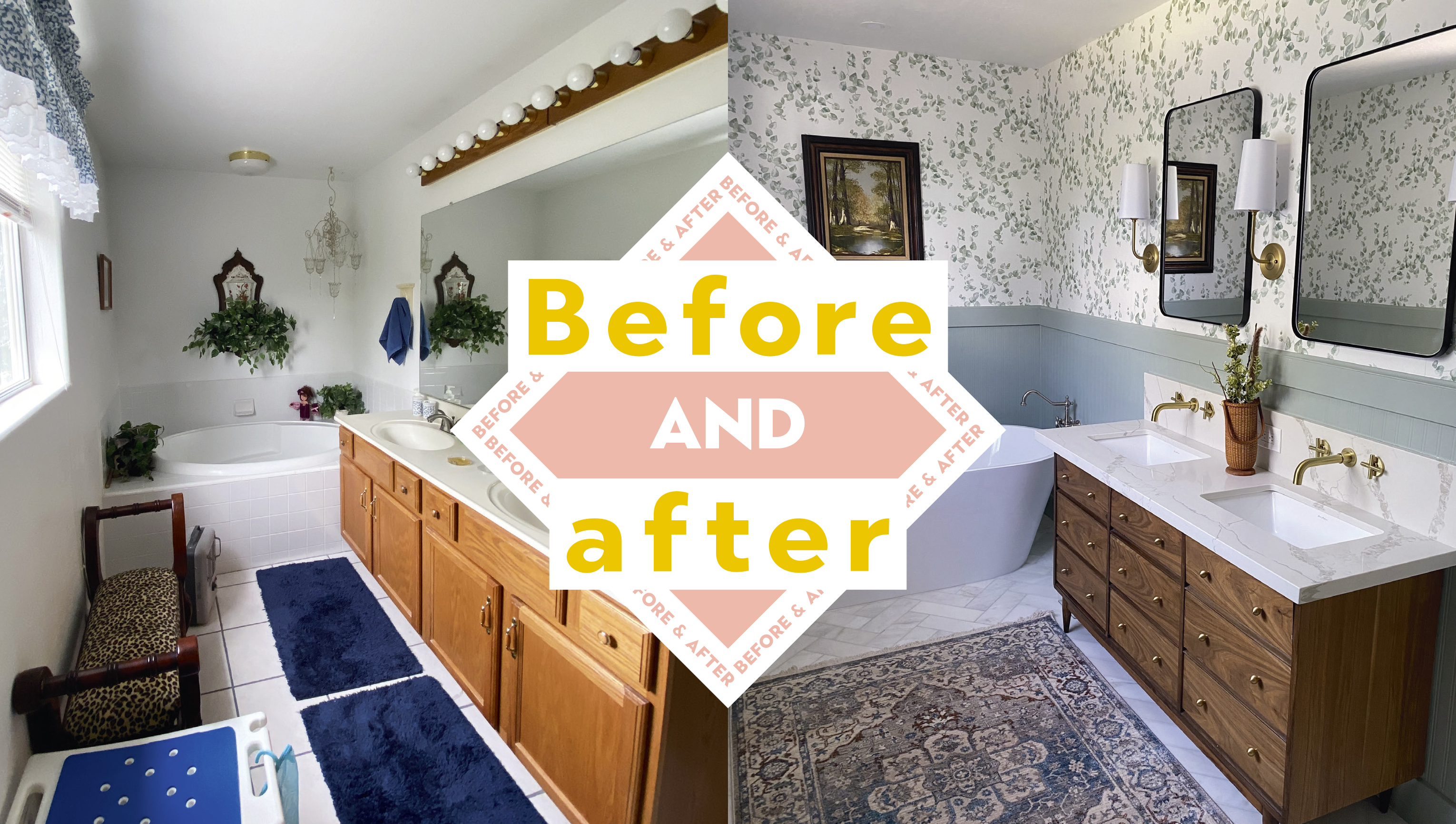 Before and After: Dated master bathroom transformed into 'jewel box' space
Before and After: Dated master bathroom transformed into 'jewel box' spaceBrooke Waite transformed her dated master bath into the ‘jewel box’ space with a cottage feel she'd always hoped for. Combining DIY, wallpaper and a ton of creativity gave beautiful results for less than you'd expect.
By Brooke Waite Published
-
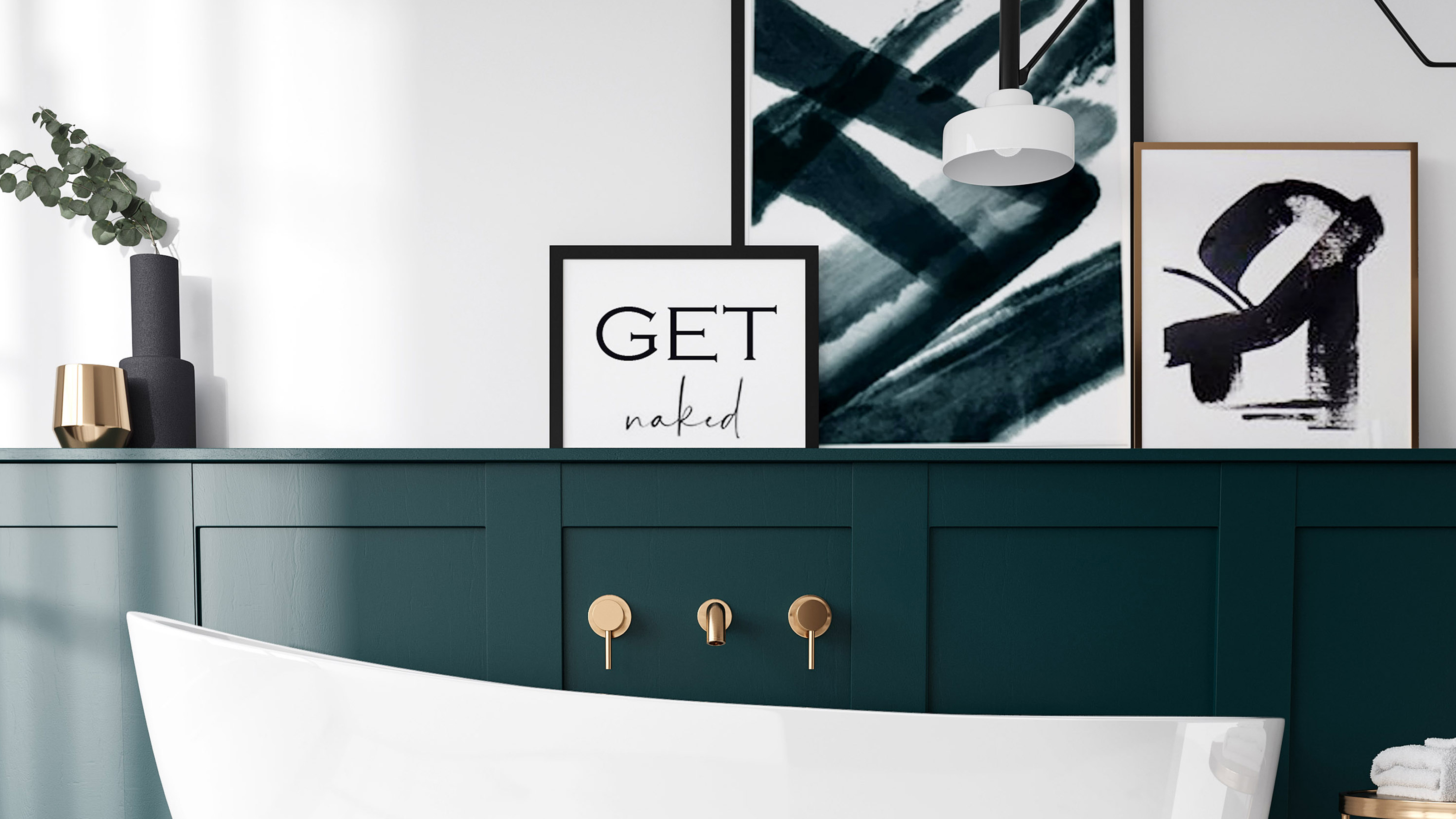 13 creative ways to decorate bathroom walls
13 creative ways to decorate bathroom wallsThese bathroom wall decor ideas will add character, fun and texture to your bathroom. 13 DIY looks to get your creative juices flowing.
By Anna Cottrell Last updated
-
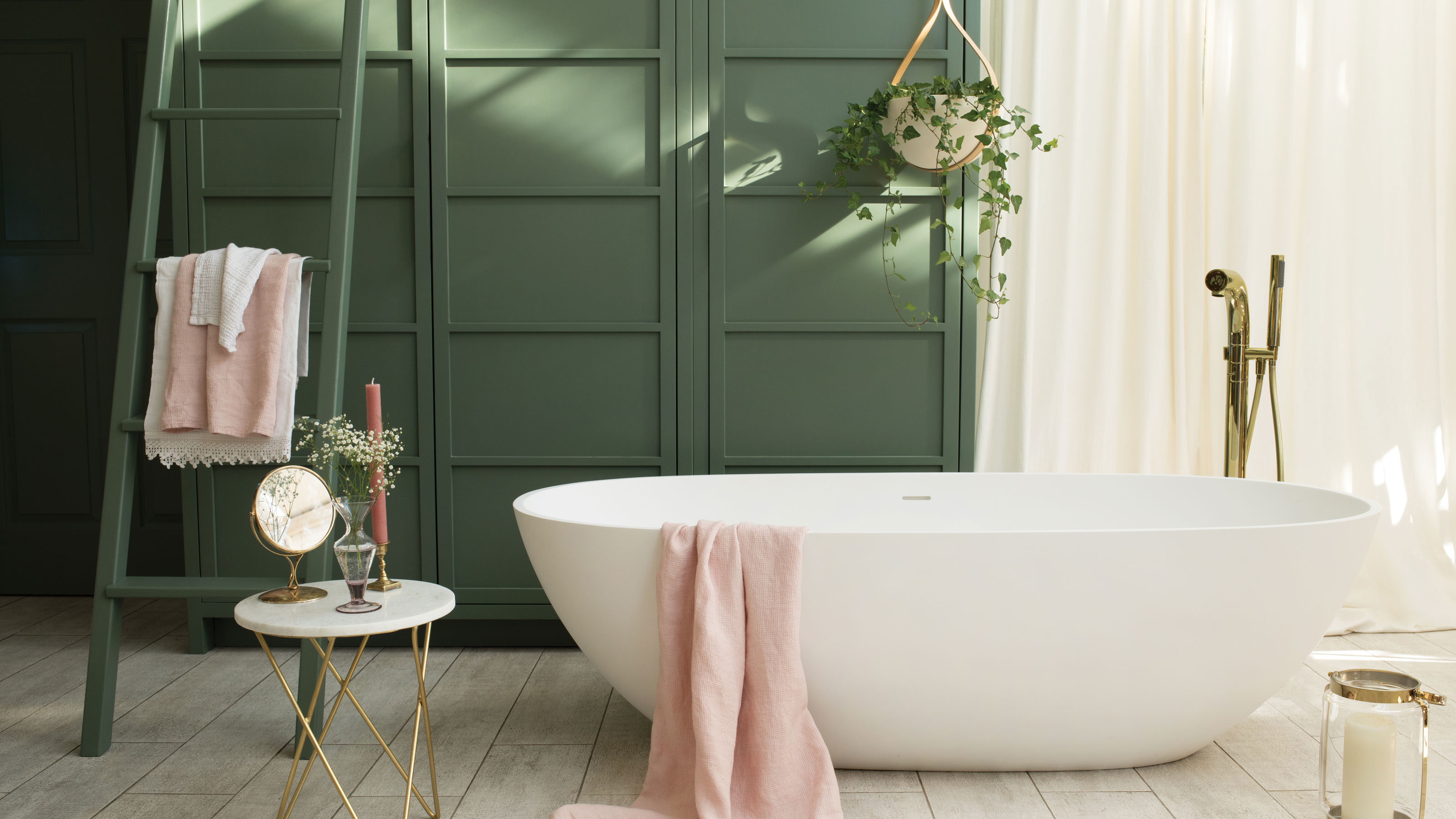 11 bathroom wall paneling ideas that add personality
11 bathroom wall paneling ideas that add personalityEnhance bathroom spaces big and small with wall paneling. Wood clad and painted bathroom wall paneling ideas will add personality in an instant.
By Michela Colling Last updated
-
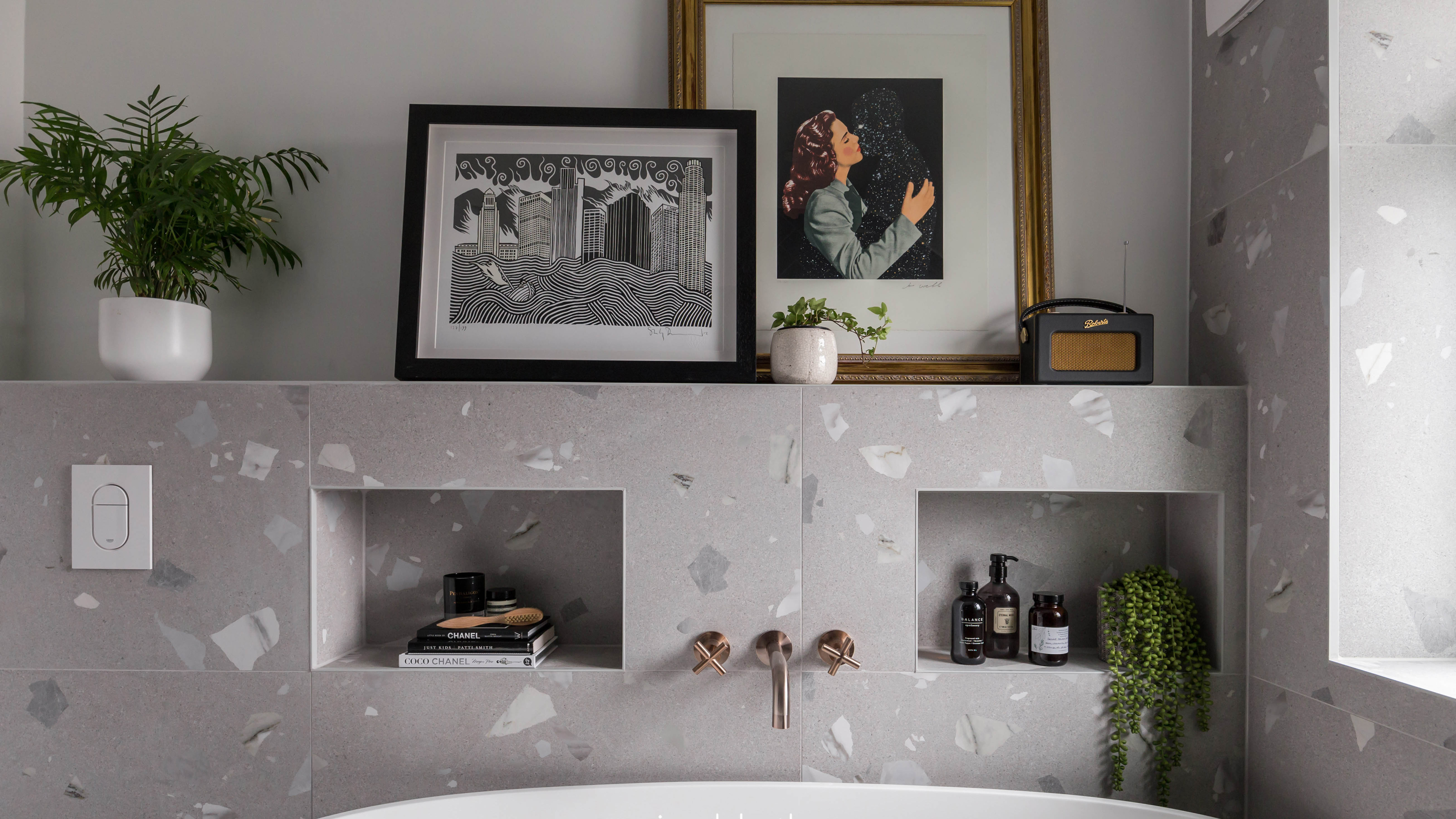 Jonathan Adler has shared a controversial tip for making your bathroom feel glamorous
Jonathan Adler has shared a controversial tip for making your bathroom feel glamorousMoody lighting is a must, according to the interior design expert
By Millie Hurst Published
-
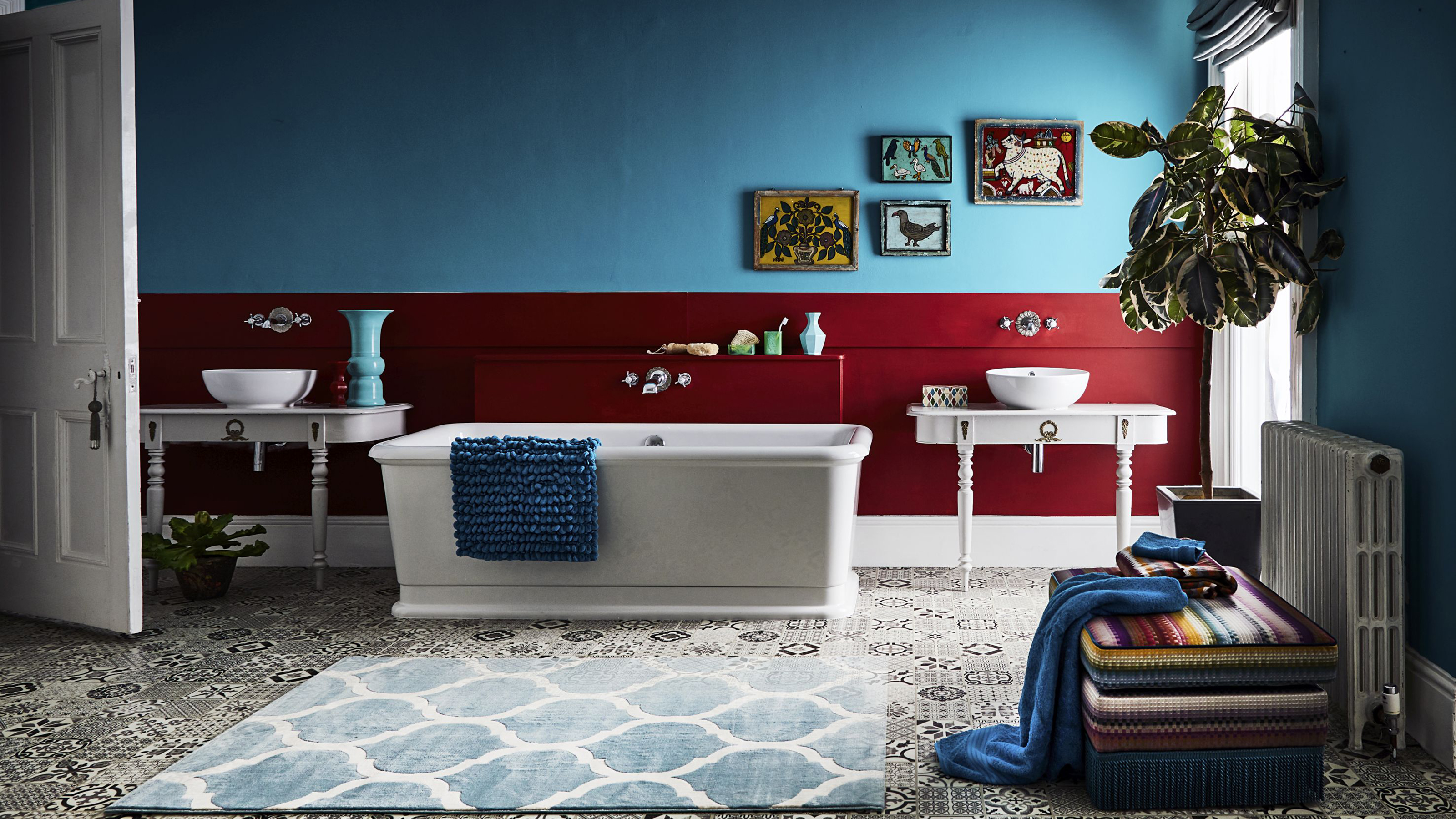 How to decorate a bathroom – a step-by-step guide on introducing color, storage and more
How to decorate a bathroom – a step-by-step guide on introducing color, storage and moreDeciding on how to decorate a bathroom? These tips will provide a starting point for a wow-factor washroom
By Christina Chrysostomou Published
-
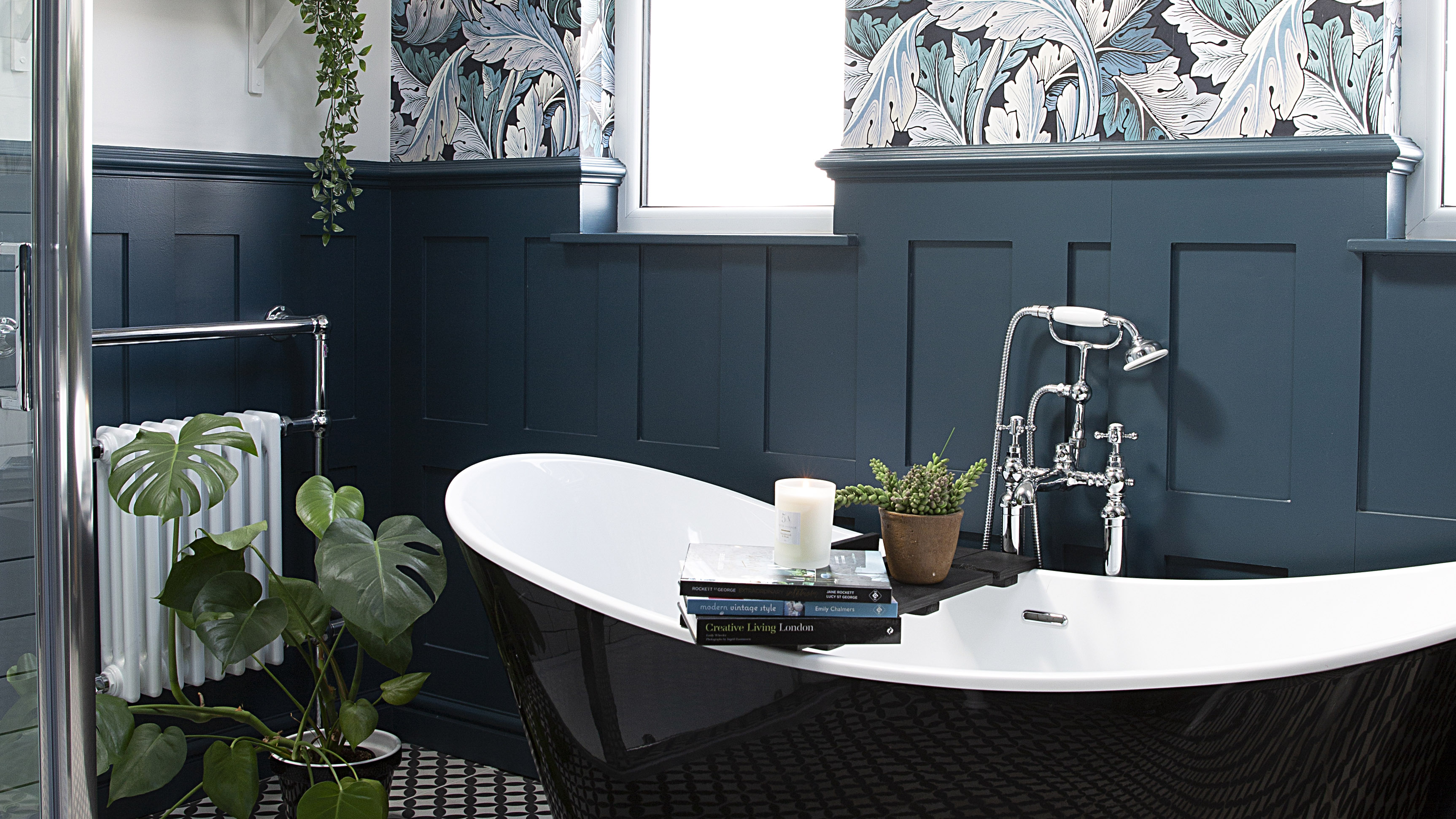 Before and after: move over bathroom tiles! There's a new wall covering in town and this bathroom does it perfectly
Before and after: move over bathroom tiles! There's a new wall covering in town and this bathroom does it perfectlyIt's the perfect space to unwind...
By Amelia Smith Published
-
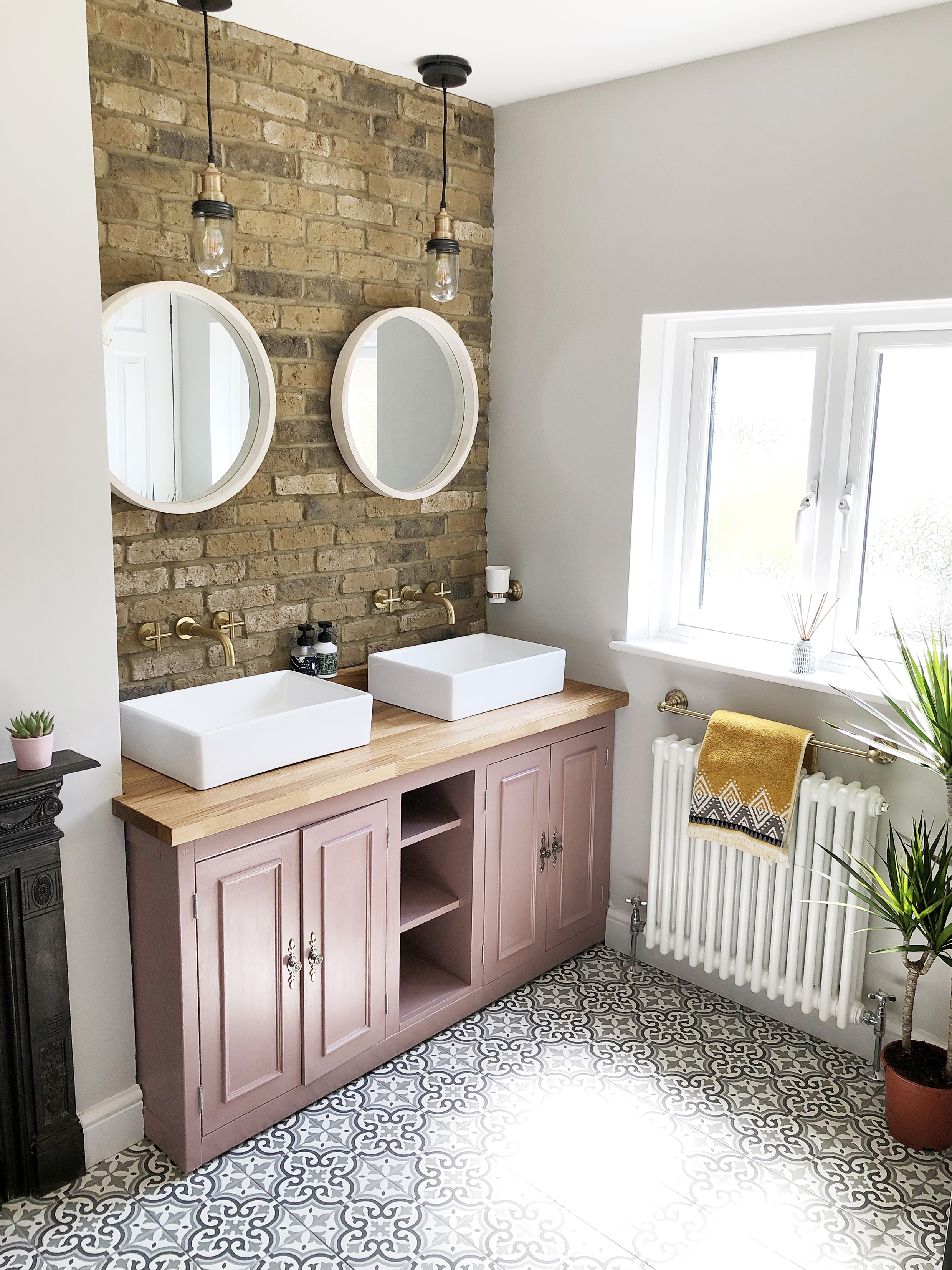 This expert bathroom lighting hack is a game-changer for getting ready in the morning
This expert bathroom lighting hack is a game-changer for getting ready in the morningShadows, be gone!
By Millie Hurst Published